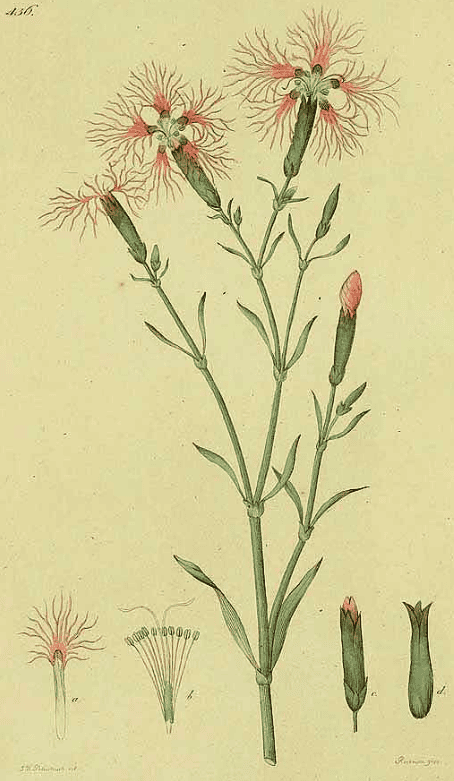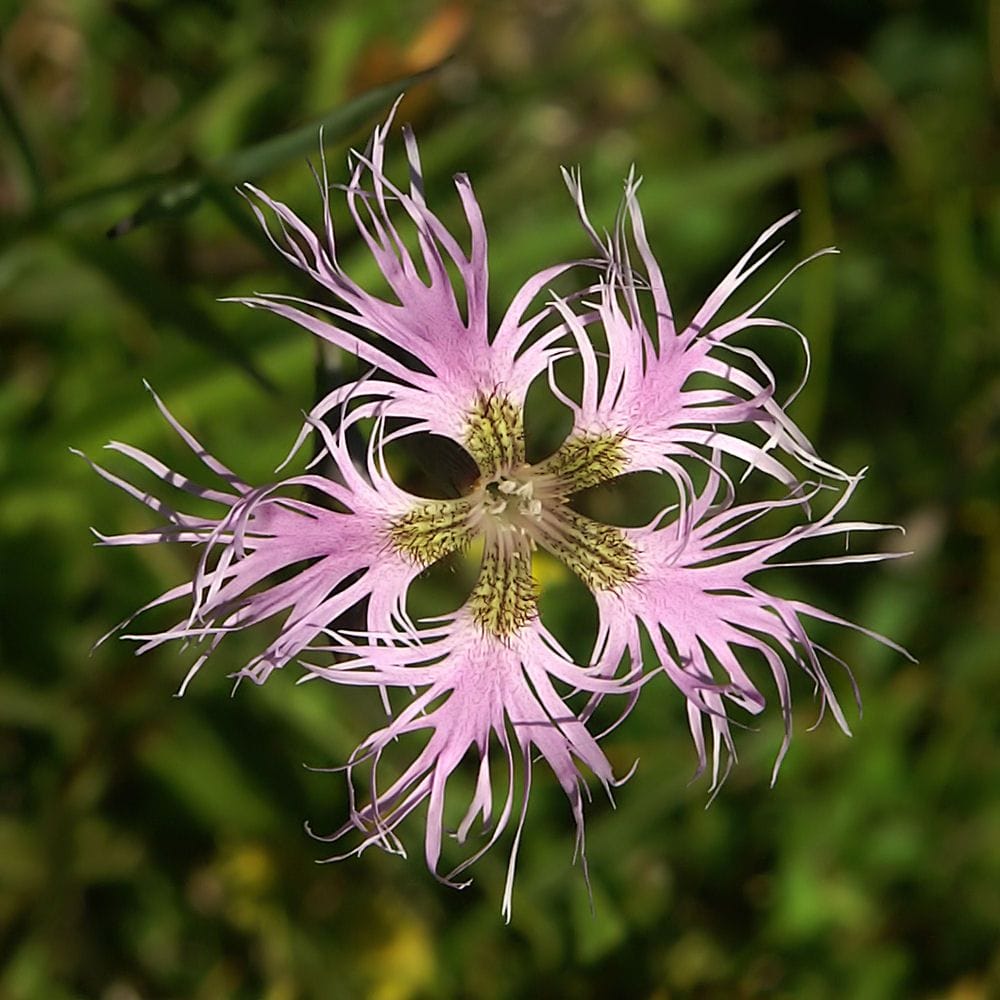Dianthus, Qu Mai 瞿麦Fringed Pink, Liliac PinkQu Mai (TCM) Smyug ma me tok སྨྱུག་མ་ མེ་ ཏོཀ (Tibetan Medicine) |

|
 Dianthus superbus
Dianthus superbusPalmstruch, J.W., Svensk botanik (1802-1838)
 Dianthus superbus
Dianthus superbus(Photo by Orchi) (Wikimedia)
Botanical name:
Dianthus spp.:
- D. superbus (Official)
- D. chinensis (Official)
- D. amurensis
- D. versicolor
Parts used:
Whole Herb or flowering tops (best)
Flowers are used in Tibetan Medicine.
Temperature & Taste:
Cold, dry. Bitter, Sweet
Classification:
C. Clears Damp, Promote Urine
Constituents
Saponins (triterpenoid and steroidal), flavonoids, phenolics, anthraquinones
Uses:
1. Clears Damp-Heat, Promotes Urine:
-painful and dribbling urination, Strangury
-Hematuria with pain
-Gravel and Stones with painful, obstructed and bloody urine
-Gonorrhea (Barefoot Doctors Manual)
-used for all mkhrispa (Bile) disorders (Tibetan Medicine)
2. Clears Heat and Toxin:
-Abscess, Boils, Carbuncles
-Chronic Sore Throat
-Eczema
-Conjunctivitis
3. Moves the Blood, Promotes Menstruation:
-Amenorrhea, Irregular Menstruation
-Uterine Bleeding
-swelling and pain with heat in the lower abdomen
-traditionally as an abortifacient
-has an anti-fertility effect (Duke)
-promotes Labor, expels afterbirth
-also used for Congestive Heart Failure
4. Promotes Breast Milk:
-occasionally used to promote Breast Milk
Dose:
Decoction: 9–15 grams
Main Combinations:
1. Difficult, Painful and dribbling Urination:
i. Dianthus with Plantain herb (Che Qian Cao)
ii. Dianthus with Polygonum aviculare Bian Xu
ii. Dianthus with Gardenia Zhi Zi
iv. Dianthus with Centella Ji Xue Cao and Plantain herb (Che Qian Cao)
v. Dianthus with Kochia Di Fu Zi, Polyporus Zhu Ling
vi. Dianthus with Imperata Bai Mao Gen, Cynanchum paniculatum, Akebia Mu Tong, Talcum, Betel nut and Glauber’s Salt (Mang Xiao) (Ben Cao Gang Mu)
vii. Dianthus with Plantain seed (Che Qian Zi), Polygonum aviculare Bian Xu, Rhubarb (Da Huang), Talcum, Gardenia Zhi Zi, Honey-fried Licorice (Zhi Gan Cao)
viii. Dianthus with Plantain seed (Che Qian Zi), Polygonum aviculare Bian Xu, Akebiae Mu Tong
2. Frequent, Urgent or Burning Urine, Dianthus with Plantain seed (Che Qian Zi), Scutellaria Huang Qin, Phellodendron Huang Bai, Alisma Ze Xie, Poria Fu Ling, Gardenia Zhi Zi, Rhubarb (Da Huang) (as in Fen Qing Wu Lin Wan of the Chinese Pharmacopoeia)
3. Strangury from Heat:
i. Dianthus with Malva Dong Gui Zi, Pyrrosia Shi Wei, Talcum (Hua Shi)
ii. Dianthus, Gardenia Zhi Zi, Licorice (Li Xiao San)
4. Hematuria with painful, dribbling urine:
i. Dianthus with Gardenia Zhi Zi, Crisium Xiao Ji, Imperata Bai Mao Gen
ii. Dianthus with Tetrapanax Tong Cao, Pyrrosia Shi Wei
5. Gonorrhea, Dianthus with Pyrrosia Shi Wei, Plantain seed (Che Qian Zi), Mallow seed (Dong Kui Zi)
5. Amenorrhea:
i. Dianthus with Chinese Motherwort (Yi Mu Cao)
ii. Dianthus with Paeonia Chi Shao, Dang Gui, Ligusticum Chuan Xiong
6. To promote Breast Milk, Dianthus with Vaccaria Wang Bu Liu Xing
7. Anti-allergy, Diamthus with Madder (shown effective against peanut allergy)
8. Chronic Sore Throat, Dianthis, Scrophularia Xuan Shen, Gardenia Zhi Zi
9. Congestive Heart Failure, Dianthus with Ginseng, Rhubarb (Da Huang), Paeonia Bai Shao, Dang Gui, Cinnamon Rou Gui, Poria Fu Ling, Licorice
Major Formulas:
Ba Zheng San
Li Xiao San
Cautions:
1. Not used during Pregnancy
2. Overdose can cause Bleeding
Main Preparations used:
-
Extra Info
-
Research
–Dianthi herba: a comprehensive review of its botany, traditional use, phytochemistry, and pharmacology
–ANTI-BACTERIAL
–ANTI-VIRAL
–ANTI-INFLAMMATORY
–ANTI-CANCER
